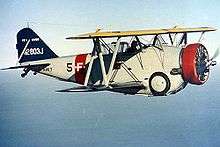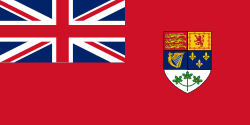Grumman FF
| FF / SF "Fifi" | |
|---|---|
 | |
| Role | Naval fighter |
| Manufacturer | Grumman |
| Designer | Leroy Grumman |
| First flight | 29 December 1931 |
| Introduction | June 1933 |
| Retired | 1940 |
| Primary users | United States Navy Spanish Republican Air Force Royal Canadian Air Force |
| Produced | 1932-1934 |
| Number built | 116[1] |
| Developed into | Grumman XSBF |
The Grumman FF "Fifi" (company designation G-5) was an American biplane fighter aircraft operated by the United States Navy during the 1930s.[2] It was the first carrier aircraft with retractable landing gear.[3] It was produced under licence in Canada and known as the Goblin in Canadian service and Delfin (en:Dolphin) in Spanish service.
Design and development
The FF-1 was Grumman’s first complete aircraft design for the US Navy. The Navy had asked Grumman if their retractable landing gear made for the O2U-1 Scout planes could be retrofitted to the Navy's Boeing F4B-1 fighters; instead Grumman proposed a new fighter design.[4] The prototype XFF-1 (serial number A8878) was built to a contract placed on 22 April 1931, first flying on 29 December of that year,[2][5][6] a two-seat design, with an enclosed cockpit, fuselage of all-metal construction, and wings covered largely with fabric. The XFF-1 was powered initially by a 616 hp (459 kW) Wright R-1820-E Cyclone radial engine, it achieved 195 mph (314 km/h) during service trials. Later the original engine was exchanged for a 750 hp (560 kW) Wright R-1820-F Cyclone and the XFF-1 reached a top speed of 201 mph (323 km/h), faster than any US Navy fighter in service at the time.[6]
A production order was placed for 27 two-seat FF-1 (G-5) on 19 December 1932. Meanwhile Grumman had completed a second prototype (serial number A8940) to a two-seat scout configuration as the XSF-1 (G-6). Subsequently 33 production SF-1s were ordered based on the two-seat configuration. They differed from the FF-1 principally in having revised internal equipment and in being powered by R-1820-84 Cyclones instead of the R-1820-78 model installed in the fighter version.[6] One XSF-2 was also completed, this having a Pratt & Whitney R-1830 Wasp engine in place of the Cyclone.[2]
Operational history
FF-1s were delivered to Fighter Squadron VF-5B of the USS Lexington beginning in June 1933.[5] In service the FF-1 became familiarly known as the "Fifi".[6] Delivery of SF-1s started on 30 March 1934, and they also served aboard the Lexington, with Scout Squadron VS-3B.[6]
Both the FF-1 and SF-1 were withdrawn from first-line US Navy squadrons by the end of 1936 and reallocated to reserve units, most of the FF-1s still being in service late in 1940. Later, 22 surviving FF-1s were modified with dual controls, redesignated FF-2 and used for instructional duties.[7]

The Canadian Car & Foundry Co acquired a manufacturing licence for the G-23, and improved FF-1, of which it completed a total of 52, some of which were assembled from US-built components. Thirty-four were acquired by the Spanish Republican Government in 1937 by presenting forged Turkish credentials. This batch was built primarily to bypass the US embargo placed on belligerents during the Spanish Civil War.[3] Referred to as the GE-23 Delfin (en:Dolphin) by the Spanish Republican Air Force, the aircraft fought in the conflict, but were outclassed by opposing fighters and losses were high. Despite this, a victory against a Heinkel He 59B would be the only recorded "kill" by a Grumman biplane fighter.[1] Eleven survived to serve in the Ejército del Aire Español, nicknamed Pedro Rico for its rotundity.[1]
Although initially rejected as a fighter by the Royal Canadian Air Force as outdated and too slow, with the advent of war, the last 15 of the CC&F production batch were taken on strength as the Goblin I. The aircraft type served with the RCAF from 17 September 1940 until 21 April 1942. "A" Flight of No. 118 RCAF Sqn was equipped with Goblins at Rockcliffe in Ottawa, and subsequently became No. 118 (Fighter) Sqn., later stationed at Dartmouth, Nova Scotia where the Goblins for a time constituted the sole fighter force on the east coast.[8]
Prior to RCAF use, single examples were delivered to Nicaragua, one to Japan, and another to Mexico.
The sole G-23 purchased by the Nicaraguan government saw limited service before being relegated to a scrap yard at Zololtan Air Field in 1942, destined to remain there until 1961 when it was purchased and shipped to the US. In 1966, Grumman restored the aircraft before passing it to the US Navy where it remains as one of the displays at the Naval Aviation Museum at Pensacola, Florida.
The Japanese example was purchased as an example of Grumman's undercarriage, however by the time it was delivered better designs were already in use.[9]
The Mexican example was intended to be a pattern aircraft to allow a production line to be set up there but this never occurred.[10]
Variants
- XFF-1
- single prototype,[1] serial number A8878[6]
- FF-1
- 27 built,[1] two-seat U.S. Navy carrier-borne fighter[6]
- FF-2
- 25[1] of the original FF-1 fighters converted by the Naval Aircraft Factory with dual controls to serve as fighter trainers[2]
- XSF-1
- one built,[1] second prototype, serial number A8940[6]
- SF-1
- 33 built,[1] two-seat U.S. Navy carrier-borne scout[6]
- XSF-2
- one aircraft,[1] an SF-1 airframe with the 650 hp (485 kW) Pratt & Whitney R-1535-72 Twin Wasp Junior engine driving a Hamilton Standard propeller[2]
- Goblin
- 52 G-23s built under licence by the Canadian Car & Foundry Company[1]
- AXG1
- A single Grumman G-23 supplied to the Imperial Japanese Navy Air Service for evaluation in 1935.
- GE.23 Delfin
- Export variant for Spain, 34-built.
Operators

 Canada
Canada- Royal Canadian Air Force
- No. 118 (Fighter) Squadron RCAF - 15 aircraft, designated Goblin I[9]
 Japan
Japan- Imperial Japanese Navy - one CC&F example designated AXG[9]
 Mexico
Mexico- Mexican Air Force - one intended as pattern for production in Mexico.[10]
 Nicaragua
Nicaragua- Military Aviation Corps - 1 example, serial GN-3[10]
.svg.png) Spanish Republic
Spanish Republic- Spanish Republican Air Force - 34 aircraft delivered serials AD-001 to AD-034[10]
- Ejército del Aire - 11 examples that survived the civil war.
 United States
United States- United States Navy
Specifications (FF-1)
Data from The Complete Encyclopedia of World Aircraft[2]
General characteristics
- Crew: two (pilot and observer/gunner)
- Length: 24 ft 6 in (7.47 m)
- Wingspan: 34 ft 6 in (10.52 m)
- Height: 11 ft 1 in (3.38 m)
- Wing area: 310 ft² (28.8 m²)
- Empty weight: 3,098 lb (1,405 kg)
- Max. takeoff weight: 4,677 lb (2,121 kg)
- Powerplant: 1 × Wright R-1820-78 Cyclone radial engine, 700 hp (520 kW)
Performance
- Maximum speed: 207 mph at 4,000 ft (333 km/h)
- Range: 685 mi (1,100 km)
- Service ceiling: 22,100 ft (6,735 m)
- Rate of climb: 1,667 ft/min (508 m/min)
Armament
- 2× 0.30 in (7.62 mm) M1919 Browning machine guns
- 1× 100 lb (45 kg) bomb
See also
- Related development
- Related lists
- List of aircraft of World War II
- List of military aircraft of the United States (naval)
- List of aircraft of Canada's air forces
- List of aircraft of the Spanish Republican Air Force
References
Citations
- 1 2 3 4 5 6 7 8 9 10 Francillon, 1989, p.62
- 1 2 3 4 5 6 Eden and Moeng 2002, p. 762.
- 1 2 Winchester 2002, p. 21.
- ↑ Jordan, Corey C. "Grumman's Ascendency: Chapter One>" Planes and Pilots Of World War Two, 2000. Retrieved: 22 July 2011.
- 1 2 Cacutt 1989, p. 155–162.
- 1 2 3 4 5 6 7 8 9 Swanborough and Bowers 1976, p. 195.
- ↑ Green and Swanborough 1988, p. 259.
- ↑ "Grumman Goblin." rcaf.com. Retrieved: 1 August 2009.
- 1 2 3 Francillon, 1989, p.60
- 1 2 3 4 Francillon, 1989, p.61
Bibliography
- Barrera, David Gesalí (2005). Delfín : el avion Grumman CC&F G-23 en la guerra civil española. Spain: Montmeló. ISBN 978-8460979777. (in Spanish)
- Cacutt, Len, ed. (1989). Great Aircraft of the World - "Grumman Single-Seat Biplane Fighters.". London: Marshall Cavendish. ISBN 1-85435-250-4.
- Eden, Paul; Moeng, Soph (2002). The Complete Encyclopedia of World Aircraft. London: Amber Books. ISBN 0-7607-3432-1.
- Francillon, Rene J. (1989). Grumman Aircraft since 1929. Naval Institute Press. ISBN 978-0870212468.
- Green, William (October 1966). "The Strange Story of Grumman's First Fighter". Flying Review International. 22 (2).
- Green, William; Swanborough, Gordon (1988). The Complete Book of Fighters. New York: Barnes & Noble. ISBN 0-7607-0904-1.
- Levy, Howard (October 1966). "All the Way Home". Air Progress. 19 (4).
- Levy, Howard (December 1966). "Canadian-built Goblin Restored". Canadian Aviation. 39 (12).
- Listemann, Phil H. (2008). Grumman FF. Allied Wings No.6. London: Philedition. ISBN 978-2953254402.
- Swanborough, Gordon; Bowers, Peter M. (1976). United States Navy Aircraft Since 1911. Annapolis, Maryland: Naval Institute Press. ISBN 0-870219685.
- Winchester, Jim (2002). Fighters of the 20th Century. Shrewsbury, UK: Airlife Publishing. ISBN 1840373881.
External links
| Wikimedia Commons has media related to Grumman FF/SF. |